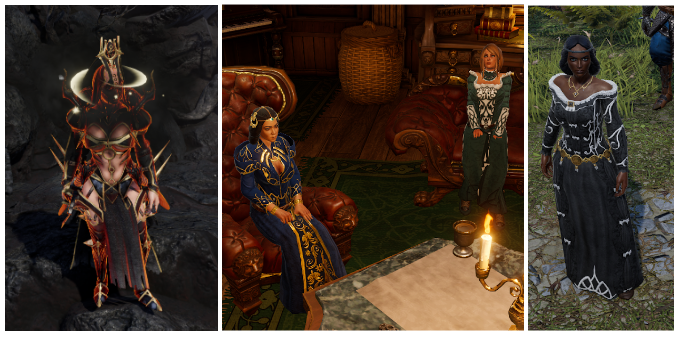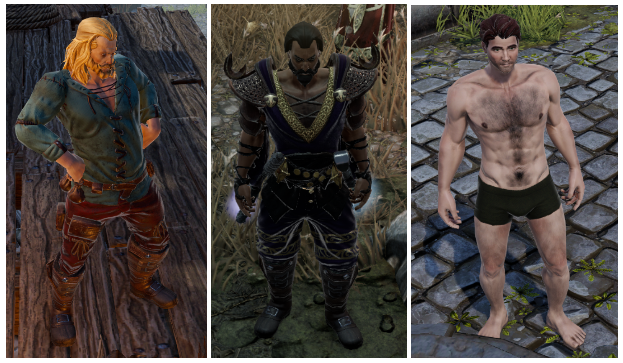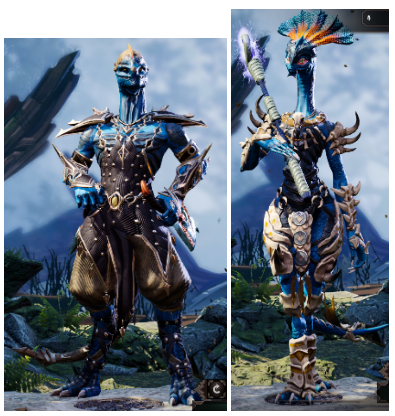By May
The fantasy genre is always a wonderful genre that allows anyone to essentially create their own world and rules and Divinity: Original Sin 2 is no exception to this idea. In this game, the creators have developed an open world viewed in third-person. In this game, you will complete missions and follow the main story with either a pre-made character or a personalized character. Throughout the game, you will pick up other characters who can join you on your mission or you can play co-op with friends. Despite the open world aspect and personalized character creation, I’ve noticed that there isn’t as much personalization as I thought.
The first obvious trait I noticed among most of the characters was how most of them shared the same body templates.


The photos above are all examples of the human characters in this game. They all share or have somewhat similar body templates. When paying closer attention to their physical traits, I noticed just how much these characters tended to follow the stereotypical standards of beauty in our society today. For the female characters, they were usually young, thin, with curves, and large breasts. The male characters were typically young, muscular, and/or fit.
While this game does follow many gender stereotypes, there are certain aspects of this game that lie beyond the social norms of gender and sex. During this game you spend a lot of time talking to NPCs and are constantly given the choice of multiple dialogue options. One option I’ve encountered several times has been the ability to romance or kiss the character you are talking to. Normally when you see this option in video games, it is typically because you are playing a character of the opposite sex. I, however, created a female character and I was given the option to romance both female and male characters in this game. I like to believe that the options remain the same if I created a male character instead.
In Megan Blythe Adams’ article, “Bye, Bye, Birdo: Heroic Androgyny and Villainous Gender-Variance in Video Games,” she brings up the aspect of characters in video games that are non-human but still appear to be “humanoid”. Now in her article, she focuses on androgyny and androgynous characters, however, I still thought this idea of humanoid characters plays an important role in Divinity: Original Sin 2 as well. In this game you can choose multiple races and one of them is a Lizard race. They have lizard-esque aspects to their appearances such as a tail, scaly skin, and a face and arms/legs that are similar to a lizard, but they also have certain human features as well. What stands out in particular is that the female lizard character design takes on many stereotypical “feminine” human aspects such as a thin frame and an obvious bust. The male lizard design does the same with stereotypical “masculine” features such as a muscular and broad frame. What I find so interesting about this observation is despite being a race completely different to humans, the developers still felt the need to essentially sexualize this race in the same way.

This game has much content to it, but I believe it lacks much diversity of character design, especially for the player’s own personal preferences. There is more diversity among NPCs than there is for the player’s choice of character creation. Given the limited choices of character creation, players are left to deal solely with what society today generally sees as typical beauty standards for both men and women. While I understand games can lack the funds to afford more visual design details such as this, it is still something to think about when it comes to other games in the future.
Works Cited:
Adams, Meghan Blythe. “Bye, Bye, Birdo: Heroic Androgyny and Villainous Gender-Variance in Video Games.” Queerness in Play, 2018, pp. 147–163, https://doi.org/10.1007/978-3-319-90542-6_9.
Perreault, Mildred F., et al. “What Does It Mean to Be a Female Character in ‘Indie’ Game Storytelling? Narrative Framing and Humanization in Independently Developed Video Games.” Games and Culture, vol. 17, no. 2, 2021, pp. 244–261, https://doi.org/10.1177/15554120211026279.
Skowronski, Marika, et al. “The Effects of Sexualized Video Game Characters and Character Personalization on Women’s Self-Objectification and Body Satisfaction.” Journal of Experimental Social Psychology, vol. 92, 2021, https://doi.org/10.1016/j.jesp.2020.104051.
SkylentGames. “Are Games Oversexualized?” YouTube, YouTube, 27 Feb. 2017, https://www.youtube.com/watch?v=QsmLdS_xC_Q.